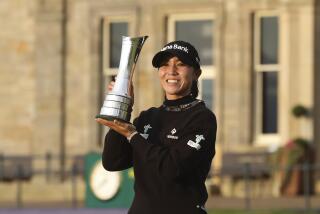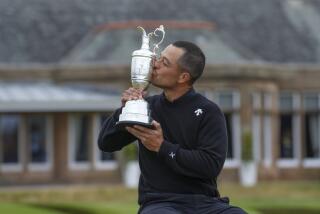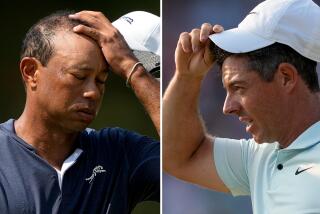French Disconnection
CARNOUSTIE, Scotland — So just how do you figure this British Open? What was it, a horrific defeat or a spectacular victory?
Of course, on a cold, damp Sunday afternoon at Carnoustie, it depends on who you’re talking about. For Jean Van de Velde of France, who had a three-shot lead with one hole to play and fell flatter than a souffle, it was awful.
But for Paul Lawrie, a 30-year-old Scot from Aberdeen, it was the thrill of a lifetime . . . and a gift victory that was wrapped and hand-delivered.
“I can’t believe it,” Lawrie said. “Incredible.”
Yes, it was that, all right. Law- rie shot a final-round 67 in the afternoon, waited around long enough to wind up in a three-way playoff with Van de Velde and Justin Leonard, then somehow found himself lifting golf’s oldest major championship trophy in a light rain.
Somebody had to win the 128th British Open at Carnoustie, and Lawrie happened to be the last man standing. Beginning the day 10 shots off the lead, Lawrie’s comeback is the biggest ever in a major. The previous biggest was Jack Burke at the 1956 Masters, who won after being eight down to amateur Ken Venturi.
In British Open history, Lawrie’s comeback doubled the five-shot margin last accomplished by Leonard in his 1997 victory at Troon.
Lawrie played the four playoff holes in even par to beat both Van de Velde, who had a final-round 77, and Leonard by three shots.
Angel Cabrera and Craig Parry tied for fourth and Greg Norman was sixth. Tiger Woods, who had a closing 74, tied for seventh with Davis Love III and David Frost.
Lawrie was a popular champion, to be sure, the first Scottish-born player to win the British Open in 68 years, since Tommy Armour won it here in 1931.
Of course, it never should have happened.
A three-shot lead with one hole to go is about as sure a thing as you will find in golf, but that’s not the way Van de Velde played it. Only one hole removed from golf’s oldest major title, the 33-year-old Frenchman absolutely fricasseed the whole deal.
“I didn’t go for glory,” Van de Velde said. “That wasn’t something mad I was trying to do. But it came out a nightmare.”
It was so apparent that he would win his name was engraved on the trophy, then had to be removed.
Van de Velde’s 18th hole was a classic disaster and very well may be the textbook for all time on how not to play a hole.
You would figure that with a three-shot lead and just one hole left, you play it safe. You do nothing risky. Maybe you bunt three eight-irons up the fairway and stay out of trouble, since you still win even if you make double bogey.
Van de Velde decided to hit a driver and knocked the ball far to the right, the ball landing in a little horseshoe shaped peninsula just behind the curve of the Barry Burn.
Second shot: Trying for the green, he bounced the ball off the right grandstand and it caromed back into the rough.
Third shot: Trying again for the green, he hit the ball into the water.
Fourth shot: One-stroke penalty.
Fifth shot: He hit it into a bunker.
Sixth shot: He hit it out of the bunker to six feet.
Seventh shot: He rolled the putt into the hole for a triple bogey seven.
Once the ball disappeared, never has someone who played a hole so poorly celebrated with such exuberance.
The whole thing was almost comical. Van de Velde played the first 71 holes of the tournament in three over and then played the 72nd hole in three over. He had birdied No. 18 two days in a row, then triple-bogeyed it.
If he just chopped the ball back onto the fairway with his second or even his third shot, he might have gotten away with it.
Parry probably was kicking himself for a three-putt double bogey on No. 17 that left him one shot out of the playoff.
And then there was Leonard. Believing he would need a birdie on the 72nd hole to catch Van de Velde, Leonard went for the green with a three wood, but the ball didn’t carry the water. Leonard wound up with a bogey and a one-over 72 at six-over 290.
“At that point, I really didn’t think it meant a whole lot,” Leonard said. “I thought I had lost.”
Well, no, he hadn’t. Van de Velde was just about to start knocking the golf ball all over the place when all he had to do was play it a little smarter--like hitting a wedge back onto the fairway and getting out of there with a six.
Van de Velde thought he was doing the right thing, even though he obviously was not. But he was able to maintain his good humor when he met reporters afterward.
“We’re going to talk about everything except 18, OK?” Van de Velde said. “The thing is, I made plenty of new friends because a Scottish man wins.
“It’s a golf tournament, it’s a game. I gave it my best shot. But next time, I hit a wedge and you all forgive me.”
Leonard, who said he never really felt comfortable hitting the ball all day, really didn’t like his tee shot on the first playoff hole, No. 15, but neither did Lawrie nor Van de Velde.
All three players blew their tee shots into wild, scruffy rough to delay the proceedings by some 15 minutes. It was the perfect tell-all scene of this British Open--three players trying to win the trophy, but standing in the middle of gorse and knee-high weeds trying to find their golf balls.
Said Leonard: “I think we were pretty much ashamed.”
Leonard, who described the playoff scene as “chaos,” was one shot down to Lawrie at No. 18, the last of the four playoff holes. Once again, Leonard went for the green to try for birdie and once again he knocked his ball into the water.
Leonard was as grim as the weather afterward and struggled to explain what happened. “I basically lost the British Open twice in one day,” he said. “That’s maybe twice as hard to take. But as bad as I feel, Jean feels worse . . . it’s got to be a sick feeling for him.”
Lawrie has missed seven cuts in 15 other European PGA Tour events. His four-under 67 was his best round in seven appearances in the British Open.
“The way the course was set up, I would have to say it’s the best round of golf I’ve ever played,” Lawrie said. “To shoot four under par around here, even with no wind, is just, you know, lovely.”
When he accepted the Claret Jug, Lawrie’s speech included thanks to his family and friends. He also thanked everyone who knows him. He also should have issued a heartfelt thanks to Van de Velde, who made it all possible, although certainly not in the usual way.
COLLAPSE ON 18
A look at the triple bogey by Jean Van de Velde on the 72nd hole of the British Open, which forced a three-way playoff won by Paul Lawrie
1. Driver far to right and into area surrounded by Barry’s Burn.
2. Two-iron to the right that hits railing on the grandstand, bounces back off the stones around the edge of the burn and into the rough.
3. Wedge into the burn.
4. Penalty drop after wading into burn to see if a shot is possible.
5. Wedge into the bunker right of the green.
6. Sand wedge out of the bunker to 8 feet.
7. Putt for triple-bogey seven.
PLAYOFF HOLES
H ow Paul Lawrie, Justin Leonard and Jean Van De Velde fared on the four-hole playoff:
*--*
Hole 15 16 17 18 Tot Par 4 3 4 4 15 Lawrie 5 4 3 3 15 Leonard 5 4 4 5 18 Van de Velde 6 4 3 5 18
*--*
MAJOR COMEBACKS
Biggest comebacks by the winner of a Grand Slam tournament heading into the final round:
BRITISH OPEN
10 strokes, Paul Lawrie, 1999*
MASTERS
8 strokes, Jack Burke, 1956
U.S. OPEN
7 strokes, Arnold Palmer, 1960
PGA CHAMPIONSHIP
7 strokes, John Mahaffey, 1978*
*won in playoff
More to Read
Go beyond the scoreboard
Get the latest on L.A.'s teams in the daily Sports Report newsletter.
You may occasionally receive promotional content from the Los Angeles Times.










